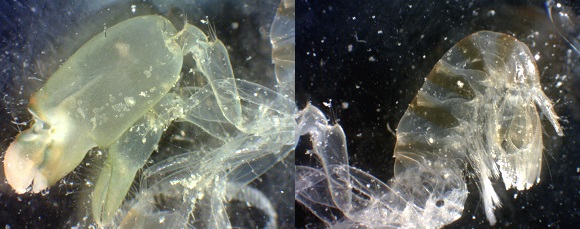Summary
Physical Description
Size
External Anatomy
Ecology
Habitat
Life History & Behaviour
Snapping Effect
Moulting
Egg Development
Internal Anatomy & Physiology
Evolution & Systematics
Biogeographic Distribution
Conservation & Threats
References & Links | Moulting
Like all crustaceans, snapping shrimp periodically go through a growing phase known as moulting. This occurs when the shrimps exoskeleton becomes too small and requires a large one to support the growing shrimp. To have continual growth, crustaceans must first remove the connective tissue which joins the hard exoskeleton with the living tissue, escape from from the exoskeleton quickly, take up water and air to help expand the new exoskeleton and gradually harden the new exoskeleton over a few days for protection and locomotion (Chang & Mykles 2011).
While examining Alpheus parvirostris on Heron Island, an individual moulted overnight. It became quite obvious which shrimp had moulted as it had separated itself from other shrimp and was hiding deep within a burrow. This behaviour is indicative of freshly moulted shrimp as they are currently in a state of vulnerability and would be easily damaged or preyed upon. Therefore by excluding itself from contact, it would increase its chances of survival during this period. The individual's shell would've been soft had it been felt, however was not touched due to not wanting to damage the hardening exoskeleton of the shrimp.

Moult of Alpheus parvirostris showing old chelae (left) and abdomen exoskeleton (right). Original Photo Aidan Janetzki 2013.

Moult of Alpheus parvirostris showing chelae, abdomen, head and carapace (left) and exoskeleton moult being removed off abdomen (right). Original Photo Aidan Janetzki 2013.
|
|